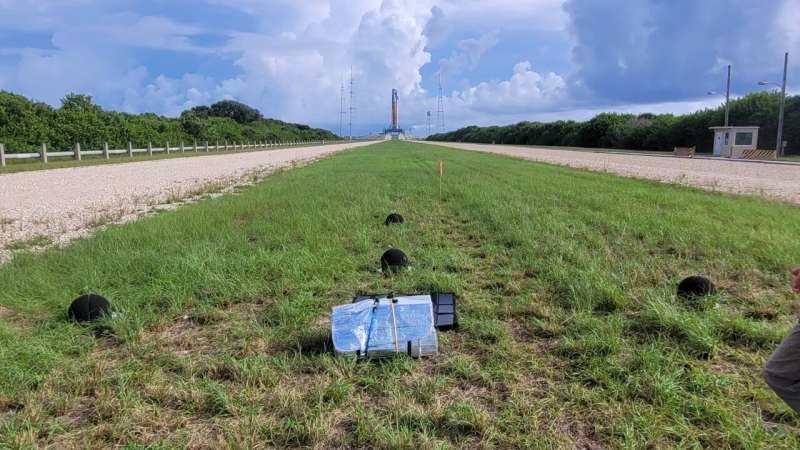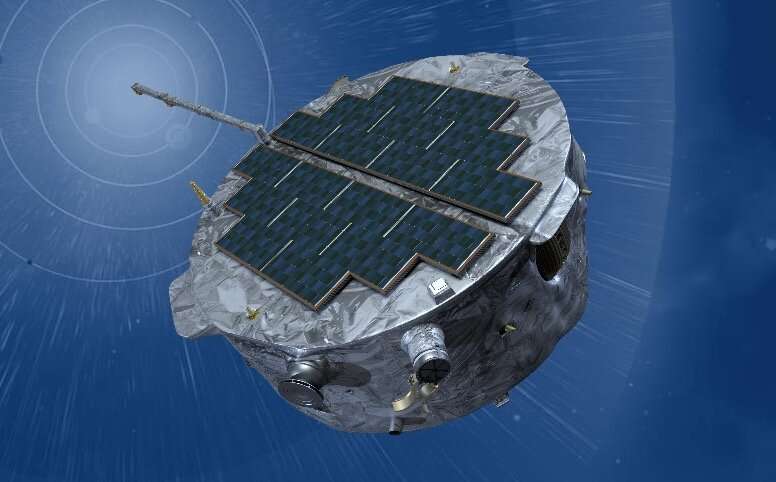Roscosmos is delaying the launch of the replacement Soyuz for crew return
Wednesday, 15 February 2023 05:22 The launch of the unmanned Soyuz MS-23, a replacement vehicle for the damaged Soyuz MS-22, was postponed until March 2023; it was originally planned to launch on February 19th, 2023, from the Baikonur Cosmodrome in Kazakhstan.
MS-23 will serve as a rescue spacecraft that will bring Cosmonauts Prokopyev, Dmitry Petelin, and NASA astronaut Frank Rubio back to Earth from the International Spa
The launch of the unmanned Soyuz MS-23, a replacement vehicle for the damaged Soyuz MS-22, was postponed until March 2023; it was originally planned to launch on February 19th, 2023, from the Baikonur Cosmodrome in Kazakhstan.
MS-23 will serve as a rescue spacecraft that will bring Cosmonauts Prokopyev, Dmitry Petelin, and NASA astronaut Frank Rubio back to Earth from the International Spa IMAP completes mission CDR on track for 2025 launch on interstellar mapping mission
Wednesday, 15 February 2023 05:22 NASA's Interstellar Mapping and Acceleration Probe (IMAP) spacecraft has completed the Mission Critical Design Review and is on track to meet its scheduled 2025 launch. Southwest Research Institute (SwRI) is managing the payload office, providing the scientific instrument Compact Dual Ion Composition Experiment (CoDICE) and is participating on other instrument teams for the mission, which will s
NASA's Interstellar Mapping and Acceleration Probe (IMAP) spacecraft has completed the Mission Critical Design Review and is on track to meet its scheduled 2025 launch. Southwest Research Institute (SwRI) is managing the payload office, providing the scientific instrument Compact Dual Ion Composition Experiment (CoDICE) and is participating on other instrument teams for the mission, which will s Perseverance shows off collection of Mars samples
Wednesday, 15 February 2023 05:22 The Red Planet rover snapped a portrait of the sample depot it has assembled with 10 backup sample tubes that could be returned to Earth by a future mission.
Even space robots know what "pics or it didn't happen" means: NASA's Perseverance Mars rover provided a panorama of its recently completed sample depot - a big milestone for the mission and humanity's first collection of samples on an
The Red Planet rover snapped a portrait of the sample depot it has assembled with 10 backup sample tubes that could be returned to Earth by a future mission.
Even space robots know what "pics or it didn't happen" means: NASA's Perseverance Mars rover provided a panorama of its recently completed sample depot - a big milestone for the mission and humanity's first collection of samples on an Complex subsurface of Mars imaged by Chinese rover Zhurong
Wednesday, 15 February 2023 05:22 Ground-penetrating radar from China's Martian rover Zhurong reveals shallow impact craters and other geologic structures in the top five meters of the red planet's surface. The images of the Martian subsurface are presented in a paper published in Geology Thursday.
The Zhurong rover was sent to Mars as part of China's Tianwen-1 mission. Launched in July 2020, the rover landed on the surfac
Ground-penetrating radar from China's Martian rover Zhurong reveals shallow impact craters and other geologic structures in the top five meters of the red planet's surface. The images of the Martian subsurface are presented in a paper published in Geology Thursday.
The Zhurong rover was sent to Mars as part of China's Tianwen-1 mission. Launched in July 2020, the rover landed on the surfac Phase II of China's deep space observation radar facility kicks off construction
Wednesday, 15 February 2023 05:22 The second phase of China's deep space observation radar facility, dubbed "China Compound Eye", started construction Tuesday in southwestern Chongqing, according to the Beijing Institute of Technology.
Covering an area of more than 300 mu (20 hectares), the new phase will see the construction of 25 high-resolution radars, each with a diameter of 30 meters, and is expected to be completed i
The second phase of China's deep space observation radar facility, dubbed "China Compound Eye", started construction Tuesday in southwestern Chongqing, according to the Beijing Institute of Technology.
Covering an area of more than 300 mu (20 hectares), the new phase will see the construction of 25 high-resolution radars, each with a diameter of 30 meters, and is expected to be completed i CSIC completes the first network of robotic telescopes present on the five continents
Wednesday, 15 February 2023 05:22 "BOOTES is the result of almost twenty-five years of continuous effort, since we installed the first station in 1998 at INTA (Arenosillo, Huelva), the institution that initially supported the project. The complete deployment represents a scientific milestone since it is the first robotic network with a presence on all continents", according to Alberto J. Castro-Tirado, scientist at IAA-CSIC acti
"BOOTES is the result of almost twenty-five years of continuous effort, since we installed the first station in 1998 at INTA (Arenosillo, Huelva), the institution that initially supported the project. The complete deployment represents a scientific milestone since it is the first robotic network with a presence on all continents", according to Alberto J. Castro-Tirado, scientist at IAA-CSIC acti Virgin Orbit elaborates on potential cause of LauncherOne failure
Tuesday, 14 February 2023 23:34
irgin Orbit provided additional details about the likely cause of its LauncherOne failure last month but didn’t estimate when the vehicle will be ready to return to flight.
Cobham to supply satellite terminals to Inmarsat for U.S. Navy network
Tuesday, 14 February 2023 17:44
Cobham Satcom will supply as many as 170 terminals to Inmarsat for the U.S.
Europe opens full-scale investigation into Viasat’s Inmarsat acquisition
Tuesday, 14 February 2023 17:39
Viasat’s plan to buy Inmarsat faces more delays after Europe launched an in-depth probe Feb.
SpaceX drops plans to convert oil rigs into launch platforms
Tuesday, 14 February 2023 16:34
SpaceX has abandoned efforts to convert two oil rigs into launch platforms for its Starship vehicle, but the company still believes that offshore launch platforms will be part of its long-term plans.
DoD can ‘tune’ space surveillance sensors to track spy balloons
Tuesday, 14 February 2023 16:31
U.S.
The roar and crackle of Artemis 1
Tuesday, 14 February 2023 15:00
When the Artemis 1 mission was launched by NASA's Space Launch System, SLS, in November, it became the world's most powerful rocket, exceeding the thrust of the previous record holder, Saturn, by 13%. With liftoff came a loud roar heard miles away.
In JASA Express Letters, researchers from Brigham Young University and Rollins College in Florida reported noise measurements during the launch at different locations around Kennedy Space Center.
The data collected can be used to validate existing noise prediction models, which are needed to protect equipment as well as the surrounding environment and community. These data will be useful as more powerful lift vehicles, including the SLS series, are developed.
"We hope these early results will help prevent the spread of possible misinformation, as happened with the Saturn 5," author Kent Gee said. "Numerous websites and discussion forums suggested sound levels that were far too high, with inaccurate reports of the Saturn 5's sound waves melting concrete and causing grass fires.
NASA's IMAP spacecraft completes mission critical design review, moves closer to 2025 launch
Tuesday, 14 February 2023 14:43
NASA's Interstellar Mapping and Acceleration Probe (IMAP) spacecraft has completed the Mission Critical Design Review and is on track to meet its scheduled 2025 launch. Southwest Research Institute (SwRI) is managing the payload office, providing the scientific instrument Compact Dual Ion Composition Experiment (CoDICE) and is participating on other instrument teams for the mission, which will study the interaction between the solar wind and the interstellar medium as well as the fundamental processes of particle acceleration in space.
Russia delays uncrewed Soyuz launch to investigate Progress leak
Tuesday, 14 February 2023 12:10
Russia has delayed the launch of an uncrewed Soyuz spacecraft to the International Space Station, intended to replace a damaged spacecraft there, to investigate damage to a second spacecraft there.
Astranis wins Space Force contract to integrate military satcom on commercial payload
Tuesday, 14 February 2023 12:00
Astranis Space Technologies won a $4.5 million contract to integrate a U.S.

